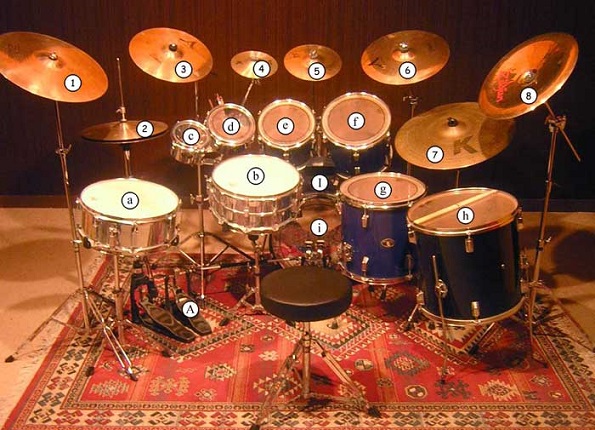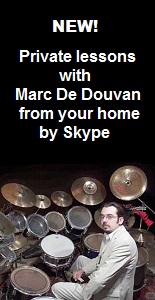
 : : : Lessons : : Conceiving your drum set : Set 7 : Metal, free groove
: : : Lessons : : Conceiving your drum set : Set 7 : Metal, free groove
Set 7 : Metal, free groove
(9 drums, 9 cymbals, 1 cowbell, 1 double pedal)

- Description:
-
- 1 : Crash 18''
- 2: Hi-hat 14''
- 3 : Crash 16''
- 4 : Splash 10''
- 5 : Splash 12''
- 6 : Crash 17''
- 7 : Leopard ride 20''
- 8: Chinese 18''
-
- a: Piccolo snare drum 12 x 5''
- b: Snare drum 14 x 6.5''
- c: Soprano tom 8''
- d: Alto tom 10''
- e: Tenor tom 12''
- f: Baritone Tom 13''
- g: Piccolo bass tom (floor tom) 14''
- h: Bass tom 16''
- i: Bass drum 22''
- I: Large cowbell
- A: Bass drum double pedal (or second bass drum 22'' with single pedal)
A first really large set apreciated by virtuoso drummers of the 1990s: Jack de Johnette (Keith Jarrett) for "free groove", Mike Portnoy (Dream Theater) for metal and progressive rock, with the addition of two latin timbales on the left instead of piccolo snare (for a while), Lars Ulrich (Metallica), at a time but with more crashes replacing splashes here, for heavy metal, Simon Phillips (Toto, Judas Priest) for prog metal rock and jazz fusion (plus a 10" suspended hi-hat, a 18" floor tom (sometimes) and a gong bass drum 20" on the right (a 22" Chinese replacing the ride, a 19" crash, the splash and an 18" crash, the Chinese) and 4 tubular toms ("octoban") placed in square above the piccolo snare, and a 22" china and ride (played as left-handed, uncrossed, above the high-hat, placed lower, under the last tom) instead of crashes, on the left (but this is not the only type of set that he used)) and Joey Jordison (Slipknot) for metal, with the addition of a suspended 13" hi-hat above and to the left of the ride, one or two Chinese above the first and one above the left hi-hat, a 14" floor tom instead of the piccolo snare, the other two being 16" and 18 ", two Greek cymbals, one huge (13" Signature Mega cup chime) placed at the extreme right, and finally, his crashes are arranged in descending from left to right .
Note the highest tom (soprano) placed under the hi-hat pedal cymbals and not above, which brings it closer to the snare but takes the hi-hat away (this is what Jack de Johnette specifically do).
The "descent of toms" (with perfect alignment) is here impressive and begins to focus on a really melodic playing on the drums. Besides, Jack DeJohnette and Terry Bozzio boast to tune their drum skins with precise tones, as if it were a melodic instrument like any other.
Ditto for cymbals, with a zigzag arrangement from the center to outside, which allows an arpeggio in single stroke roll (alternating one cymbal per hand). All drummers don't make it like that but I find it very interesting. This is an idea used a lot by Terry Bozzio, who uses his Chinese cymbals as a keyboard. Moreover, he designed Chinese cymbals especially for him, which are thicker and partially chiselled to give more precise and dried notes ("Radia" cymbals by Sabian).
With two bass drums, instead of a double pedal, you can set up a pair of suspended toms on each bass drum (with a double toms holder for bass drum),which creates a very ergonomic and aesthetic symmetry. This symmetry favors a playing with timpanist grip (“match grip”, symmetrical, like hammers), which allows these drummers to pass blithely from fingers, wrist, arm or shoulder pulse. This possibility gives a variety of dynamics like nothing else, and they don't hesitate.
Note also the symmetry of the set up of cymbals but slightly shifted to the right, making the hi-hat matching the ride, placed on both sides of the suspended toms (at the same height) and below the other cymbals, aligned, such as a keyboard, which allows you to make continuous single stroke rolls passing easily from one to another (a specialty of Jack de Johnette, to create soundscapes, notably with mallets). If we add the line of the snare drum and floor toms, down below, it gives three lines of instruments clearly separated, in arc of circle.
Note in this regard that the higher you go, the more the position of skins and cymbals is tilted vertically, to keep the same striking angle with sticks, like a kind of keyboard in 3 dimensions. The resulting effect is as superb as practical. This is a good example of architectural "functionalism" style applied to a musical instrument, which, by the coherence of its placing, allows us to see a set of disparate instruments finally unified and ordered (a bit like the pipes of an organ), which is obviously not without sound consequences. I would like to insist here on the three-dimensional character of the perception of the drumset (thanks to stereophony) and whatever the set elsewhere, because each instrument is clearly localizable in relation to the other. The set acts therefore directly on the musical result, whatever the gestures it induces. The classical score is quite incapable to show this effect, which thus varies from one set to another for the same polyphonic composition.
Finally, note the absence of suspended hi-hat, some metal drummers preferring the beating of open hi-hat or ride, when they play the double pedal in independence (like Lars Ulrich or Mike Portnoy, for example) and other drummers using no double pedal with this setup, like Jack de Johnette.
Marc De Douvan, march 2006, augmentation and translation in English: march 2015.
© 2005 Marc de Douvan Crédits Mentions légales
